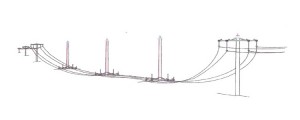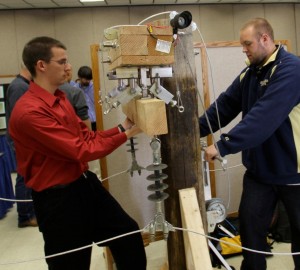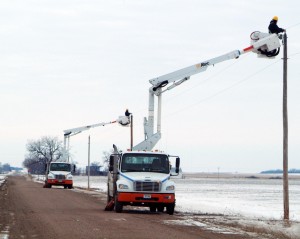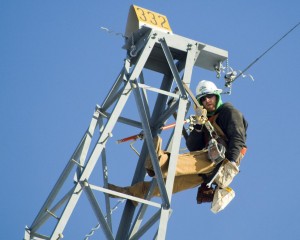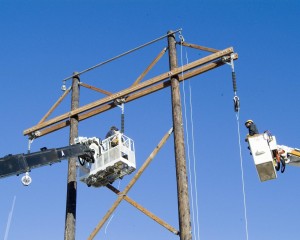Mr. Dennis Bell and Grid Defender, Inc. have developed and patented an enhancement to commonly-used overhead electrical power lines. By incorporating the ability to raise and lower cross arms and conductors from the ground, construction and maintenance can be performed faster, more safely and at a lower cost compared to current methods. A study by Industrial Engineering students at Montana State University estimates that the Grid Defender apparatus could cut power line construction by 14% or $9,123 per mile for a commonly used power line configuration. One critically important attribute of Grid Defender is its ability to shut off power when the cross arms with conductors are lowered. This feature would serve to protect the public as well as linemen in the case of catastrophic events such as storms or automobile crashes when “live” power lines normally fall to the ground. By hardening the electrical grid, Grid Defender offers the potential for reducing human suffering and loss of personal property that commonly accompanies catastrophic events. Small scale prototypes have been built to demonstrate the concept, and practitioners agree with the concept’s potential.
The profit opportunities for the owners of the Grid Defender are very large. The analysis by the IE students showed a ROI over a 7 year planning horizon to 21% if a $6.6 million plant were constructed to make the Grid Defender apparatus. Further analysis by Dr. Lanford identified some calculation errors that moved the ROI to 1159%. Over the 7 year analysis period annual after tax cash flows would rise from $3.6 million in year 1 to $24.8 million in year 4 and continue at that level through year 7. Due to the simplicity of Mr. Bell’s invention, the apparatus could be made and assembled in any well qualified machine shop thus eliminating the initial capital for a manufacturing plant which might preclude some profit but would drastically reduce the risks associated with startup manufacturing. If a manufacturing plant were used, the students designed it to make 450,000 Grid Defender apparati per year. Based on the current replacement of power poles (10% per year), 29 plants would be needed. Assuming that 2.4 million poles need to be replaced each year due to storms and other catastrophic events, another 5 plants would be needed. With 34 plants scattered across the lower 48 states, after a ramp-up period for manufacturing, after tax profit could be $843 million per year.
Mr. Bell is a veteran of bringing novel concepts to commercial reality with over 30 patents – most of which have been commercialized. He envisioned, patented, and manufactured products in current high demand such as synthetic rifle stocks by Bell and Carlson and bicycle seats made by Moon Saddle. He has helped other inventors with the patenting process. He is the recipient of the Alexander Graham Bell Award for prolificy. Dr. Bob Lanford is retired from Auburn University but hold adjunct professorships with Auburn and Clemson Universities. His work in forest engineering resulted in many popular and refereed publications. He has consulted with a number of companies and taught continuing education classes for over 20 years. His specialty is the analysis of businesses from the basics of assemble line productivity and costs to the financial aspects for company formulation. He has developed 2 different manufacturing facilities during his career and has consulted with other companies. Dr. Lanford is assisting Mr. Bell in his efforts to bring Grid Defender to commercialization.

